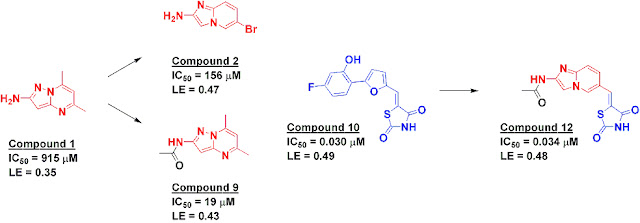The authors document what many investigators have independently observed: some fragments, as expected theoretically, are less selective than larger molecules, but other fragments are quite selective.
They also note that fragments that bind to any protein tend to be slightly more lipophilic than fragments that don’t bind to any target proteins, suggesting that hydrophobic interactions are important:
Hydrophobic interactions play a major role in protein–ligand interactions and are known to be non-directional, thus allowing binding to a multitude of pockets in different conformations. By contrast, hydrogen bonds were shown to confer specificity but do not always add much binding free energy. This is due to the cost of desolvating both the donor and acceptor of the hydrogen bond, which can nearly equal the benefit of the hydrogen bond formation. Therefore, if the hydrogen bond acceptors or donors are not satisfied in the complex, it is likely that more hydrophobic fragments will be preferred.This observation—lipophilicity for binding energy, hydrogen bonds for specificity—is consistent with the recent publication from Mike Hann and Andrew Leach, which finds that promiscuity increases with increasing lipophilicity.
One figure in the Barelier and Krimm paper shows 30 fragment-like “privileged scaffolds” that should bind to multiple proteins. What struck me is these molecules’ overwhelmingly planar character: more than half are completely aromatic (such as quinoline and indole), and only one is completely aliphatic. Barelier and Krimm note that:
The low specificity of these molecules is probably owing to their rigid and aromatic structures, well-adapted to protein hydrophobic pockets where π-stacking with phenylalanine and tyrosine are commonly observed.This reminds me of Tony Giannetti’s talk at the FBLD San Diego meeting earlier this month, where he also noted that fragment hits tend to be relatively flat. Of course, given the negative correlation between aromaticity and good pharmaceutical properties, just because aromatics are frequent hits doesn’t mean they are necessarily the best hits – they may be tricks rather than treats. All of which comes back to a key question for library design: do you focus on the flat “privileged” scaffolds that will likely have high hit rates in your assay but may have baggage, or on the more three-dimensional compounds that may have lower hit rates but may ultimately be more developable?




